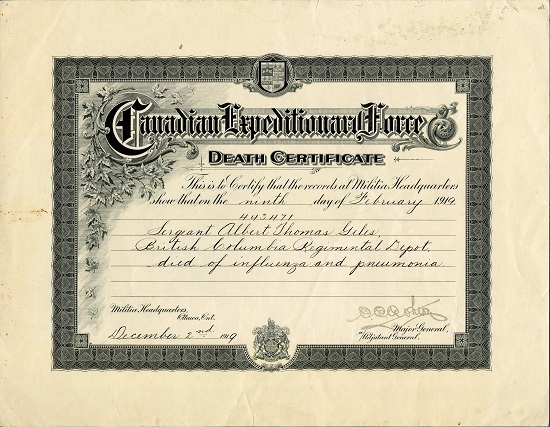
By Blake Heathcote, Director, Testaments.ca and Neil Orford, DHP Program Leader, Testaments.ca
Testaments.ca at OHASSTA
Commemorating the 100th Anniversary of the Spanish Flu Pandemic in Canada 2018-2019
A National Commemorative Research Project for Students Across Canada
In January 1920, Stan McVittie was a fit and robust electrical engineer working at a hydro-electric generating plant on the Wahnapitae River in Northern Ontario. Just six years out of university, he loved his work and the outdoor life he’d known all his life. The future was brilliant. While his young wife and daughter were visiting her parents in St. Marys, Stan developed a mild cough and a fever, but nothing to worry about for a healthy 6’ 2” outdoorsman in his prime. A few days later while visiting his father and sister in Sudbury, his symptoms worsened slightly, so he paid a call on the family doctor ‘just to be safe.’ Nine days later Stan was dead from the Spanish Flu, like 50,000 other Canadians who’d died since the Pandemic first appeared eighteen months earlier.
In a stunningly short span of time, the Spanish Flu took almost as many Canadian lives as had been killed during the four years of the Great War. Indiscriminate and horrific in its proportions and the speed with which it spread and killed, the Pandemic profoundly impacted the history of Canada. Consider the following:
One third of the world’s population was infected by the Spanish Flu;
- 50% of those infected were healthy young men and women under 40;
- 3% of the world’s population died;
- The Spanish Flu killed more people in 18 months than AIDS has killed in 35 years, or the Black Plague killed in 100;
- Stories that such statistics tell are seemingly endless.
But… Canadians responded with purpose and determination;
- The Pandemic brought about the creation of the Federal Department of Health;
- The Pandemic also persuaded Canadians to recognize disease as being a community problem, not an individual one.
Isn’t this a story our students should know?
Scholarship
This political and social upheaval caused by the Pandemic is well-chronicled by eminent Canadian historians, such as Mark Humphries in The Last Plague: Spanish Influenza and the Politics of Public Health in Canada (2013); Esyltt Jones’ Influenza: Disease, Death and Struggle in Winnipeg (2007); and OHASSTA’s own Mike Clare in his 2015 iBook, “Stepping Out with the Spanish Lady,” written for the Canadian Century Digital Scrapbook series. The global scope of the Pandemic has been investigated with precision by Laura Spinney in her 2017 publication, Pale Rider: The Spanish Flu of 1918 and How it Changed the World.
The Spanish Flu is now understood by all as a contributing factor to the end of the Great War, and the subsequent economic turmoil of 1919-20. What we know little about is how the Pandemic affected individual Canadians and communities throughout every province and region. Unknown stories such as Stan McVittie’s represent a ‘micro-history’ of our country.
Testaments.ca
Over the next 24 months, Testaments.ca (a Canadian-owned digital education service) will be leading research projects with schools, heritage organizations, and community groups across Canada to commemorate the 100th Anniversary of the Spanish Flu Pandemic.
In 2018, working in coordination with the Ministry of Canadian Heritage, Library and Archives Canada (LAC), Wilfrid Laurier University, and dozens of Canadian school boards, organizations, and institutions, Testaments.ca will launch our ‘Digital Commons’ platform. This will provide a nationwide forum for students in Arts, History, or Science classes to create and share commemorative projects and content, featuring local and regional stories about the Pandemic.
Using the award-winning Digital Historian Project™ (DHP) model for experiential learning, teachers who subscribe to the Testaments.ca Commemoration Program (at no cost) can explore the history, science, and public health stories of 1918–1920 with their classes. The core concept of the DHP is to provide students with digital storytelling skills and tools, and to empower them in their explorations researching history, language arts, and social studies.
Each student chooses a person or an event that has some personal meaning for them (a family connection, something from their community), and that student then explores the Spanish Flu Pandemic from the perspective of that person or event. Specifically, they construct or ‘tell’ a story from that singular personal perspective as a means of coming to better understand the Pandemic, and to bring a large subject into focus through a more intimate, human lens.
A major feature of the DHP is our ‘7 Sentence Storytelling Guide’, which introduces students (in any discipline) to the principles of structured narrative. On our website, we will provide downloadable learning materials, assets, templates, online tutorials, and digital research inquiry lessons to guide them every step of the way. When complete, their stories are presented in any digital medium (eBooks, websites, videos, interactive displays, exhibits), and shared on Testaments.ca’s Digital Commons.
The digital framework is one of the many reasons why the innovative DHP is such a powerful learning template, and why it forms the foundation of the Ontario Ministry of Education’s 2016 document, Community-Connected for Experiential Learning. The Project was featured on the Ministry’s EDUGains website, and was also recognized with a Government of Canada History Award in 2015.
Combining the strengths and skills of digital research, storytelling, independent study, and multi-disciplinary thinking, the DHP offers schools and museums across the country an exemplary template for conducting digital research with students in virtually any subject discipline. For example, with history teachers it encourages the integration of data management principles into historical inquiry classwork. Statistical evidence thereby becomes a significant factor in guiding student learning.
Commemoration for the 21st Century
The commemoration of the 100th Anniversary of the Spanish Flu Pandemic in your program will engage your students in rich historical inquiry, and establish connections for them that extend far beyond the classroom. You can display your students’ work for an audience across the country on the DHP’s Digital Commons, and ‘crowd-share’ the Canadian stories that have impacted and shaped our history. This commemorative project will make you and your students a significant part of our national heritage.
Testaments.ca wants OHASSTA teachers to:
- Register your class for this Commemorative Project;
- Help conduct research for your community;
- Design and share rich engaging lesson plans;
- Curate content on our digital platform;
- Tell 12,000+ Canadian Spanish Flu stories over the next 24 months.
- Learn more about the DHP and the significance of the Spanish Flu Pandemic at: www.Testaments.ca
- Visit our Exhibitor’s Table at the OHASSTA 2017 Conference and sign-up for our Workshop.
- Make your stories a part of our Canadian heritage for the 21st Century.


